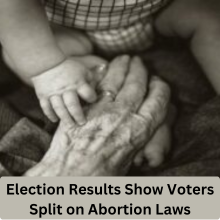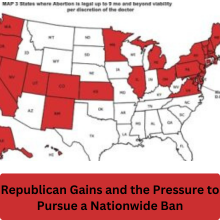
In the 2024 U.S. elections, voters sent a clear but contradictory message regarding abortion rights. While seven states passed ballot measures expanding abortion access, voters also elected a slate of Republican candidates who could pave the way for a national abortion ban. This paradox highlights a disconnect between public support for abortion rights and political actions that may restrict them.
The results reveal the complexity of the abortion debate in America—one that combines deeply held personal beliefs, party politics, and the influence of powerful interest groups. This article explores the implications of these results and what they mean for the future of abortion access in the U.S.
Understanding the Voter Disconnect on Abortion
In 2024, voters showed strong support for abortion rights in several states. Yet, many of the same voters also elected politicians who oppose abortion, even to the point of supporting a nationwide ban. This contradiction has raised important questions about the motivations behind voting behavior and the future of reproductive rights in the U.S.
The Disconnect
While states like Missouri, Arizona, and Montana approved measures to protect abortion access, Republican candidates—who are increasingly advocating for abortion restrictions—gained significant ground across the country. Despite this, voters did not seem to see any contradiction between their support for abortion rights on the ballot and their decision to back anti-abortion candidates in other races.
The Role of Ballot Measures in Shaping Abortion Laws
What Are Ballot Measures?
Ballot measures allow citizens to directly vote on proposed laws or amendments to the state constitution. These initiatives are a form of direct democracy, where voters decide on specific policies, bypassing the legislature. Ballot measures have become one of the key tools used to protect or expand abortion access in states where elected officials may not act in line with the majority’s views on reproductive rights.
Recent Ballot Measures in 2024
In 2024, abortion rights were front and center in many states, where voters had the chance to decide the fate of abortion laws through ballot measures. These measures allowed voters to bypass state legislatures, which in many cases had passed restrictive abortion laws.
States That Voted to Protect Abortion Rights
Missouri, Arizona, and Montana were among the states where voters overwhelmingly supported abortion rights. In Missouri, voters reversed one of the country’s strictest abortion bans, reinstating abortion access until fetal viability (around 24 weeks). Arizona, which had a 15-week abortion ban, moved to restore access until viability, while Montana reinforced abortion rights by passing a constitutional amendment protecting the procedure.
Close Calls and Defeats
However, not all states embraced expanded abortion access. Florida’s attempt to enshrine abortion rights until fetal viability fell short by just a few percentage points, as it failed to meet the 60% threshold required for constitutional amendments. Similarly, in Nebraska and South Dakota, voters rejected abortion rights measures, leaving restrictive abortion laws intact.
Republican Gains and the Pressure to Pursue a Nationwide Ban
Republican Control and the Trifecta
One of the major outcomes of the 2024 election was the significant gain Republicans made at both the state and federal levels. With control over the House, and a likely Republican-controlled Senate, the party is now positioned to push through a nationwide abortion ban in the near future. A “trifecta” of Republican leadership could lead to the passage of a national law that overrides state-level protections.
Trump’s Stance on Abortion
Donald Trump, who was re-elected as president in 2024, waffled on the issue of abortion during his campaign. Initially, he downplayed its significance, but as the election progressed, he adopted a “leave-it-to-the-states” position. While Trump has previously indicated he would not support a national abortion ban, there is increasing concern among abortion rights advocates that his administration may pivot and support such a ban, overriding state-level protections.
The Influence of External Campaigns on Voter Behavior
Pro-Abortion Campaign Messaging vs. Conservative Messaging
The election results also reflect the influence of external campaigns, especially from interest groups on both sides of the abortion debate. Groups like SBA Pro-Life America spent millions of dollars on voter mobilization, particularly in battleground states, to influence the outcome. Their messaging often framed abortion as a moral issue, rallying conservative voters around candidates who oppose abortion rights.
On the other side, pro-abortion rights campaigns focused on the importance of bodily autonomy and the protection of reproductive rights. Yet, many experts believe these messages could have been more effective if they had tied abortion access more directly to economic issues, which are often top concerns for voters.
The Power of Super PACs and Large-Scale Mobilization
Super PACs and outside groups played a significant role in shaping voter opinions. These groups have the financial resources to run extensive ad campaigns and mobilize voters, especially in battleground states. With both pro-abortion and anti-abortion groups heavily invested in the outcome, their influence cannot be underestimated.
The Economic and Democratic Context of the Abortion Debate
How Abortion Ties Into Economic Issues
Abortion is not just a moral or health issue; it is also closely tied to economic outcomes. The ability to access abortion allows individuals to make decisions that impact their economic stability and future. Proponents of abortion rights argue that restrictions disproportionately affect low-income individuals and people of color, who may not have the resources to travel to states with more lenient abortion laws.
Abortion and Democracy
Beyond economics, abortion is also a critical issue for the health of democracy itself. Restricting abortion access can be seen as a direct attack on individual freedoms, particularly for women. As the fight for abortion rights intensifies, it becomes increasingly clear that the outcome will shape not just healthcare access but the very foundation of democratic principles in the U.S.
Also read: Elon Musk & Grimes House Hunting Together in Bel-Air
The Future of Abortion Rights in America
What’s Next for State-Level Abortion Rights
While the federal government remains a key battleground for abortion rights, state-level actions will continue to be crucial. As seen in 2024, states like Missouri, Arizona, and Montana are pushing back against restrictive federal laws by passing their own protections. However, these protections are at risk, particularly with the possibility of a national ban under a Republican administration.
Federal Action: What Could Happen Under a Republican Administration?
Under a second Trump administration, federal action could significantly limit abortion access. One possibility is the re-enforcement of the Comstock Act, which could restrict the mailing of abortion medication, effectively banning telemedicine abortions. There could also be federal moves to stop enforcing existing laws that require hospitals to provide emergency abortion care, further undermining abortion access in the U.S.
Also read: The Truth Behind Macaulay Culkin’s “Cabin Alone” Disney+ Movie
Conclusion
The 2024 election results highlight a critical disconnect in American politics regarding abortion. While voters continue to support abortion rights, the election of anti-abortion candidates could pave the way for a national ban. Understanding this complex dynamic is essential for advocates and voters alike, as the fight for reproductive rights continues to unfold at both the state and federal levels.
FAQs
How do ballot measures work and what role do they play in abortion laws?
Ballot measures allow voters to directly approve or reject laws and constitutional amendments. They play a key role in shaping abortion access, especially in states where lawmakers are unwilling to act.
Why did voters support abortion rights yet elect anti-abortion candidates?
Many voters are driven by a combination of issues, such as the economy, immigration, and party loyalty. This often leads to conflicting decisions on specific issues like abortion.
Could a Republican Congress pass a national abortion ban?
Yes, with Republican control of both the House and Senate, there is a real possibility of a nationwide abortion ban, which would override state protections.
How does the economy influence abortion voting behavior?
Economic issues, such as access to healthcare and financial stability, are closely linked to abortion access. Voters may support candidates who align with their broader economic interests, even if they hold opposing views on abortion.
What are the potential future threats to abortion access under a Trump administration?
A second Trump administration could use existing laws to curtail abortion access, such as banning abortion medication or refusing to enforce existing abortion care mandates in hospitals.

